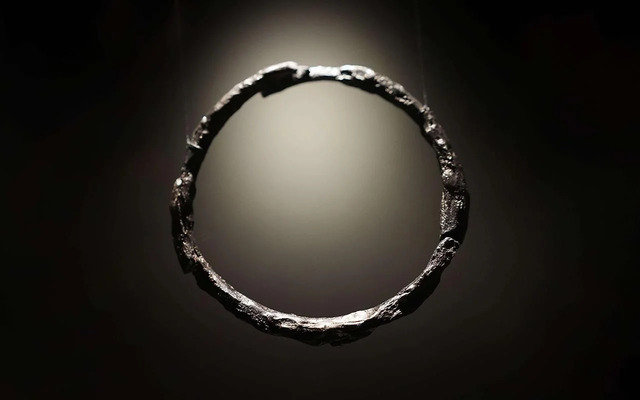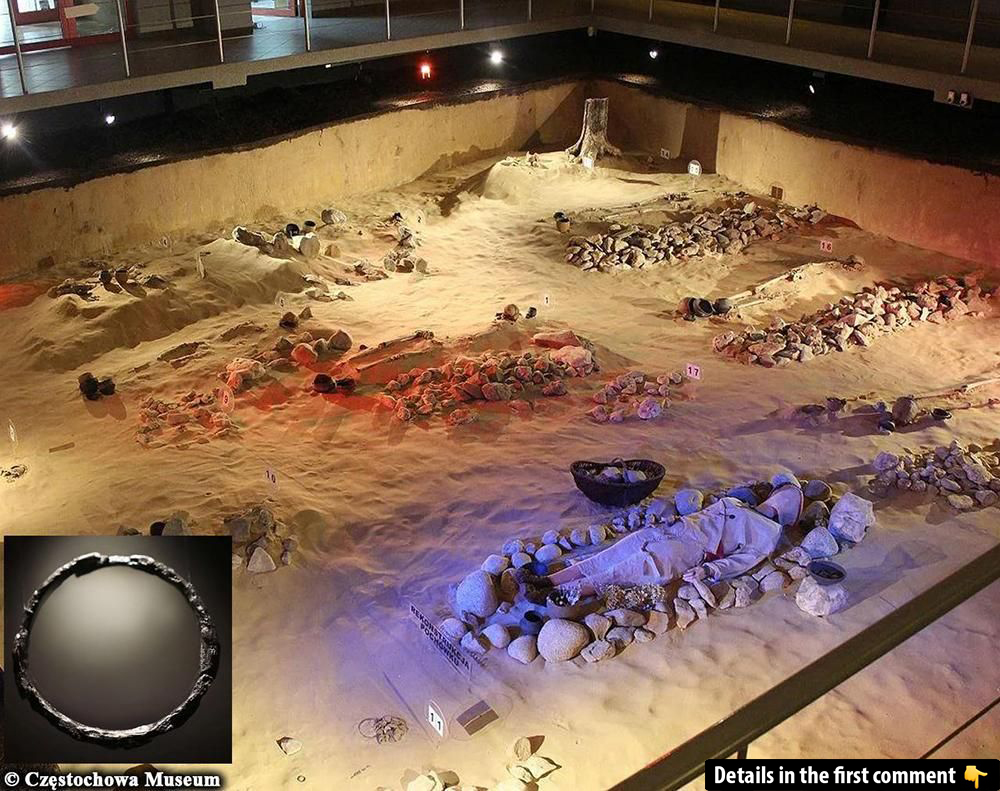Imagine crafting jewelry from a material that fell from the sky, carrying the secrets of the cosmos. In Poland, archaeologists have uncovered such ancient treasures—bracelets, rings, and pins made from meteoritic iron. This discovery, dating back to the early Iron Age, not only reveals the advanced metallurgical skills of the Lusatian culture but also sheds light on their unique connection to the universe. Join us as we explore how these cosmic ornaments redefined the use of iron and its significance in early human craftsmanship.
The Lusatian Culture: A Glimpse into Early Iron Age Burial Practices
The Lusatian culture, which flourished between 750–600 BCE, spanned areas that are now Poland, the Czech Republic, Slovakia, eastern Germany, and western Ukraine. This culture was known for its advanced craftsmanship in both ceramics and metallurgy. The recent discovery in Poland came from two burial sites, Częstochowa-Raków and Częstochowa-Mirów, both of which have provided invaluable insight into the customs and material culture of this ancient society. The burials themselves are an essential part of understanding the Lusatian culture, as they shed light on the status, rituals, and beliefs surrounding death and the afterlife.
In these burial sites, archaeologists found several jewelry pieces, including bracelets, an ankle ring, and a pin—all crafted from meteoritic iron. These findings were significant not only because they were made from such a rare material but also because they provided a deeper understanding of how these ancient people viewed and utilized the resources available to them. The ornaments were placed in graves, pointing to their role in burial rites and their symbolic significance in the context of death. This aligns with the broader burial practices of the Lusatian culture, where grave goods were believed to help the deceased in their journey to the afterlife.
Video
Check out the video on ancient jewelry made from meteorites discovered in Poland – it’s a stunning find!
The Meteorite Jewelry Discovery: A Breakthrough in Archaeology

The discovery of meteoritic iron jewelry was nothing short of a breakthrough in archaeology. While meteorites have long been a source of fascination and mystery, this find represents one of the largest known groups of such artifacts at an archaeological site. Previously, only two meteoritic iron bracelets had been documented in the Częstochowa Museum’s collection, but a re-examination of these artifacts by scientists from Poland and France revealed three additional ornaments, making it one of the most significant discoveries of its kind.
The burial sites in Częstochowa-Raków and Częstochowa-Mirów, which date back to the early Iron Age, provided a wealth of material for analysis. These ornaments were not just simple adornments—they were part of the cultural and spiritual practices of the Lusatian people, representing their connection to the cosmos. The fact that these items were made from meteorites speaks to the special reverence these people had for objects that fell from the heavens. In an age before the scientific understanding of meteorology, the presence of these rare materials in burial practices likely held symbolic and ritual importance.
Analyzing the Meteorite Iron: Techniques and Findings
The analysis of these meteoritic iron ornaments was conducted using state-of-the-art scientific methods, providing unprecedented insights into the origins of the material and how it was used. Researchers employed portable X-ray fluorescence spectrometry (p-XRF) and scanning electron microscopy with energy-dispersive spectroscopy (SEM/EDS) to analyze 26 artifacts from the sites. These cutting-edge techniques enabled the team to identify high levels of nickel, a hallmark of ataxites—a rare type of iron meteorite. The findings suggest that all five meteoritic iron artifacts came from a single meteorite, likely a contemporary fall rather than an imported material.
The analysis also revealed varying compositions within individual pieces, suggesting that metalworkers mixed meteoritic iron with smelted iron to achieve specific aesthetic or structural effects. This method predates the well-known production of wootz and Damascus steel by almost a millennium, raising fascinating questions about early metallurgical innovations. The ability to work with both meteoritic and smelted iron highlights the craftsmanship of ancient artisans, who had already developed sophisticated methods of working with different types of metals.

The Role of Meteorite Iron in the Lusatian Culture
Historically, meteoritic iron was considered a material of great rarity and value. In the Bronze Age, civilizations often regarded meteorite iron as possessing sacred or magical properties due to its celestial origins. However, the use of meteoritic iron by the Lusatian culture during the early Iron Age signals a shift in the perception of this material. Rather than reserving it for religious or symbolic purposes, the Lusatian people appear to have viewed meteorite iron as a more accessible and practical raw material, incorporating it into their everyday objects.
This shift in the use of meteoritic iron is evident in the fact that the burial sites contained both meteoritic and smelted iron objects. This suggests that the Lusatian culture did not view meteoritic iron as a sacred material reserved for the elite or religious rituals. Instead, it was used alongside other forms of iron, indicating its broader cultural and practical significance. The incorporation of meteoritic iron into everyday life reflects the Lusatian people’s ability to adapt and innovate with the resources available to them.
The Metallurgical Practices of the Lusatian Culture
The discovery of meteoritic iron jewelry in the Lusatian graves offers a new perspective on the metallurgical practices of early Iron Age societies. The fact that metalworkers were able to mix meteoritic iron with smelted iron to achieve specific effects speaks to their advanced knowledge of metallurgy. These artisans were not simply using iron in its natural form; they were experimenting with different types of iron to create objects with unique properties.
The technique of mixing meteoritic and smelted iron hints at the early development of advanced metallurgical practices that would eventually lead to the creation of more complex alloys. This predates the well-known use of wootz and Damascus steel by several centuries, offering a glimpse into the ingenuity of early metalworkers who were able to manipulate materials to suit their needs. The ability to craft ornaments from meteorite iron also suggests a level of sophistication and artistry that was highly advanced for its time.
The Significance of Local vs. Imported Iron in Early Metallurgy
An intriguing aspect of this discovery is the relationship between local meteoritic iron and imported terrestrial iron. According to Dr. Karol Dzięgielewski, Poland has no evidence of local iron smelting during this period, meaning that the terrestrial iron found in the objects was likely imported. However, the meteoritic iron used to make the jewelry was almost certainly local, which raises interesting questions about how ancient craftsmen collected and worked with this rare material.
The use of local meteoritic iron alongside imported terrestrial iron underscores the complex trade networks that existed during the early Iron Age. These networks allowed the Lusatian people to access materials from distant places, while simultaneously taking advantage of local resources like meteorites. The combination of local and imported materials in the creation of jewelry speaks to the adaptability and resourcefulness of early societies in utilizing whatever resources were available to them.
Implications for Future Research: Expanding Knowledge of Ancient Metallurgy
The discovery of meteoritic iron jewelry in Poland opens the door to further exploration of ancient metallurgy. Researchers are now considering how these findings might influence the understanding of metalworking techniques in other ancient cultures. The Lusatian culture’s use of both meteoritic and smelted iron may offer insights into the development of early metallurgy and could lead to the discovery of similar objects in other archaeological sites across Europe.
Future research is likely to focus on expanding the scope of this study to other burial sites in Poland and beyond, to see if similar meteoritic iron artifacts can be found elsewhere. By comparing these findings with those from other Iron Age cultures, researchers hope to gain a deeper understanding of how ancient societies approached metallurgy, trade, and resource utilization.
Video
Watch the video from Pawn Stars to see how a meteorite is valued as VERY OLD and VERY EXPENSIVE – it’s a fascinating moment!
Conclusion: Understanding Ancient Craftsmen Through Cosmic Materials
The discovery of ancient jewelry made from meteorites not only enhances our understanding of the Lusatian culture but also sheds light on the early development of metallurgy in ancient societies. The use of meteoritic iron as a raw material, combined with smelted iron, challenges previous assumptions about how early metalworkers operated. This find provides valuable insight into the technological, artistic, and cultural practices of the Iron Age, demonstrating the ingenuity of ancient craftsmen who worked with materials as rare and precious as those that fell from the stars.
As we continue to explore these ancient techniques, this discovery reminds us of the interconnectedness of human innovation, culture, and the natural world. The craft of the Lusatian people serves as a testament to the resourcefulness of early societies and their ability to shape their environment, one cosmic material at a time.



